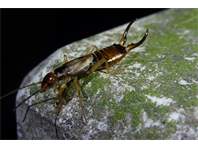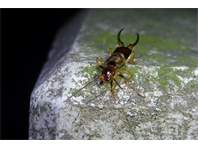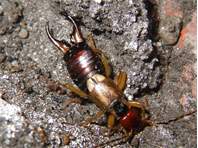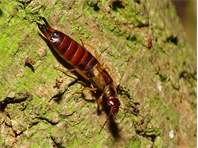Diagnose
Körperlänge: 12–15 mm.
Kopf: rotbraun bis schwarz, Fühler schnurartig mit 11–14 Gliedern.
Thorax: Halsschild schwarzbraun, seitlich sowie Beine hellbraun. Flügel vorhanden.
Hinterleib: schwarzbraun, Zangen (Cerci) basal hell-, dann rotbraun. Beide Geschlechter besitzen lange Zangen, die der Männchen stark gekrümmt, basal flach, verbreitert und innen mit zwei Zähnen, die der Weibchen mehr oder weniger gerade und spitz zulaufend.
Gesetzlicher Schutz und Rote Liste
—
Merkmale
Verbreitung
Heimisch in Europa, Nordafrika und Westasien. Eingeschleppt in andere temperate Regionen der Erde, so in Nordamerika (Guillett et al. 2000), Australien, Neuseeland (Quarrell et al. 2018) und die Falklandinseln (Maczey et al. 2019).
Lebensweise
Lebensräume
Bestandssituation
Literatur
- Guillet, S., N. Josselin & M. Vancassel 2000: Multiple introductions of the Forficula auricularia species complex (Dermaptera: Forficulidae) in Eastern North America. – Canadian Entomologist 132 (1): 49–57.
- Köhler, G. & A. Kopetz 2007: Die Jahresaktivität des Gemeinen Ohrwurms, Forficula auricularia Linnaeus, 1758, auf einem Kalktrockenrasen (Insecta: Dermaptera). – Thüringer Faunistische Abhandlungen 12: 137–141.
- Kölliker, M. 2007: Benefits and costs of earwig (Forficula auricularia) family life. – Behavioral Ecology and Sociobiology 61: 1489–1497.
- Kuhl, W., 1928: Die Variabilität der abdominalen Körperanhänge von Forficula auricularia L. unter Berücksichtigung ihrer normalen und abnormalen Entwicklung, nebst einem Anhang über Geschlechtsbiologie. – Zeitschrift für Morphologie und Okologie der Tiere 12: 300–532.
- Lamb, R. J. 1976: Polymorphism among males of the European earwig, Forficula auricularia (Dermaptera: Forficulidae). – The Canadian Entomologist 108 (1): 69–75.
- Lamb, R. J. 1976: Parental behavior in the Dermaptera with special reference to Forficula auricularia (Dermaptera: Forficulidae). – The Canadian Entomologist 108 (6): 609–619.
- Maczey, N., D. Moore, P. González-Moreno & N. Rendell 2019: Introduction of biological control agents against the European earwig (Forficula auricularia) on the Falkland Islands. S. 389–393. – In: C. R. Veitch, M. N. Clout, A. R. Martin, J. C. Russell & C. J. West, Island invasives: scaling up to meet the challenge. Occasional Paper SSC no. 62. Gland, Switzerland: IUCN.
- Mueller, T. F. , L. H. M. Blommers & P. J. M. Mols 1988: Earwig (Forficula auricularia) predation on the woolly apple aphid, Eriosoma lanigerum. – Entomologica Experimentalis et Applicata 47 (2): 145–152.
- Neubert, D., S. Simon, R. G. Beutel & B. Wipfler 2017: The head of the earwig Forficula auricularia (Dermaptera) and its evolutionary implications. – Arthropod Systematics & Phylogeny 75 (1): 99–124.
- Quarrell, S. R., J. Arabi, A. Suwalski, A. Suwalski, M. Veuille, T. Wirth & G. R. Allen 2018: The invasion biology of the invasive earwig, Forficula auricularia in Australasian ecosystems. – Biological Invasions 20: 1553–1565.
- Raveh, S., D. Vogt & M. Kölliker 2016: Maternal programming of offspring in relation to food availability in an insect (Forficula auricularia). – Proceedings of the Royal Society B 283:20152936.
- Van Meyel, S., S. Devers & J. Meunier 2019: Love them all: mothers provide care to foreign eggs in the European earwig Forficula auricularia. – Behavioral Ecology 30 (3): 756–762.
- Walker, K. A. & R. D. Fell 2001: Courtship roles of male and female European earwigs, Forficula auricularia L. (Dermaptera: Forficulidae), and sexual use of forceps. – Journal of Insect Behavior 14: 1–17.
- Weyrauch, W. K., 1929: Experimentelle Analyse der Brutpflege des Ohrwurmes Forficula auricularia. – Biologisches Zentralblatt 49: 543–558.
- Wirth, T., R. Le Guellec, M. Vancassel & M. Veuille 1998: Molecular and reproductive characterization of sibling species in the European earwig (Forficula auricularia). – Evolution 52: 260–265.
Links
Autor(-en): Matthias Nuß. Letzte Änderung am 24.11.2020
|

Männchen des Gemeinen Ohrwurms im Park Bischheim im Haselbachtal am 25.07.2019
(© Tilmann Adler)
Männchen des Gemeinen Ohrwurms im Park Bischheim im Haselbachtal am 25.07.2019 (© Tilmann Adler)( Bild vergrößern)

Männchen des Gemeinen Ohrwurms im Park Bischheim im Haselbachtal am 25.07.2019
(© Tilmann Adler)
Männchen des Gemeinen Ohrwurms im Park Bischheim im Haselbachtal am 25.07.2019 (© Tilmann Adler)( Bild vergrößern)

Männchen des Gemeinen Ohrwurms , Leipzig,17.09.2010
(© Danilo Matzke)
Männchen des Gemeinen Ohrwurms , Leipzig,17.09.2010 (© Danilo Matzke)( Bild vergrößern)

Weibchen des Gemeinen Ohrwurms in der Gemarkung Hohenprießnitz, Oktober 2018
(© Michael Happ)
Weibchen des Gemeinen Ohrwurms in der Gemarkung Hohenprießnitz, Oktober 2018 (© Michael Happ)( Bild vergrößern)
|